Koji Enokura ( 1942 – 1995) was a Japanese painter and installation artist.
He was one of the key members of Mono-ha, a group of artists who became prominent in the late 1960s and 1970s. The Mono-ha artists explored the encounter between natural and industrial materials, such as stone, steel plates, glass, light bulbs, cotton, sponge, paper, wood, wire, rope, leather, oil, and water, arranging them in mostly unaltered, ephemeral states. The works focus as much on the interdependency of these various elements and the surrounding space as on the materials themselves. From the beginning of the 1970s, Enokura stained paper, cloth, felt, and leather with oil and grease. He also discolored the floors and walls of galleries and outdoor spaces. These installations are no longer extant but are documented in photographs.
He was one of the key members of Mono-ha, a group of artists who became prominent in the late 1960s and 1970s. The Mono-ha artists explored the encounter between natural and industrial materials, such as stone, steel plates, glass, light bulbs, cotton, sponge, paper, wood, wire, rope, leather, oil, and water, arranging them in mostly unaltered, ephemeral states. The works focus as much on the interdependency of these various elements and the surrounding space as on the materials themselves. From the beginning of the 1970s, Enokura stained paper, cloth, felt, and leather with oil and grease. He also discolored the floors and walls of galleries and outdoor spaces. These installations are no longer extant but are documented in photographs.





















































